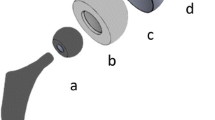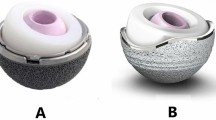Abstract
Introduction
Since 1962, the low friction arthroplasty developed by Sir John Charnley has given us very good long terms results at more than 40 years follow up, but dislocation remains a major complication. The dislocation rate is a permanent risk during the life of the patient and the prosthesis, defined by J. Caton and D. Berry in 2004 as a cumulative risk. History and concept development: The concept of dual mobility was thought up by G. Bousquet, A. Rambert and J. Rieu in the 1970s (1974-1979). The first one in 1979 was called NOVAE and combined two articulations: one large and one smaller by a recruitement phenomenon increasing the jumps distance and so decreasing dislocation forces. In 2003, D. Noyer published the first paper about the «third articulation»: a true metal/PE bearing. Since 1996, twenty years after the first patent, many dual mobility cups have been developed with various fixation ways and various designs.
Conclusion
Today with the same principles there are many differences for the «third generation» with excellent results at more than ten years FU with less than 1% to 2% dislocation rate in primary, revision, recurrent THA dislocation and THA after femoral neck fractures.











Similar content being viewed by others
References
Huten D (1996) Luxations et subluxations des prothèses totales de hanche. Conférences d’enseignement de la SOFCOT Elsevier, Paris 55: p.19-46.
Berry DJ, von KM, Schleck CD, Harmsen WS (2004) the cumulative long-term risk of dislocation after primary Charnley total hip arthroplasty. J Bone Joint Surg Am 86-A:9–14
Australian Orthopaedic Association National Joint Replacement Registry. (2014) Annual Report.cturner@aoanjrr.org.au
AJRR. (2014) Second American Joint Replacement Registry: annual teport on hip and Knee Arthroplasty Data, AAHKS.www.ajrr.net.
Aubriot JH, Lesimple P, Leclercq S (1993) Study of Bousquet’s non-cemented acetabular implant in 100 hybrid total hip prostheses (Charnley type cemented femoral component). Average 5-year follow-up. Acta Orthop Belg 59(1):267–71
Bousquet G, Argenson C, Godeneche JL, Cisterne JP, Gazielly DF, Girardin P, Debiesse JL (1986) Recovery after aseptic loosening of cemented total hip arthroplasties with Bousquet’s cementless prosthesis. A propos of 136 cases. Rev Chir Orthop Reparatrice Appar Mot 72(2):70–4
Fessy MH, Bejui J, Fisher LP (1993) Bousquet’s threaded stem in first-intention total hip arthroplast. Acta Orthop Belg 59(1):207–11
Caton JH, Prudhon JL, Ferreira A, Aslanian T, Verdier R (2014) A comparative and retrospective study of three hundred and twenty primary Charnley type hip replacements with a minimum follow up of ten years to assess whether a dual mobility cup has a decreased dislocation risk. Int Orthop 38:1125–29
Prudhon JL, Ferreira A, Verdier R (2013) Dual mobility cup: dislocation rate and survivorship at ten years of follow-up. Int Orthop 37:2345–50
Leclercq S, Benoit JY, de Rosa JP, Tallier E, Leteurtre C, Girardin PH (2013) Evora chromium-cobalt dual mobility socket: results at a minimum 10 years’ follow-up. Orthop Traumatol Surg Res 99:758–64
Alacoque M. (1978) L’avenir du cartilage du cotyle face à une prothèse fémorale (Recul maximum de 17 ans). Medical Thesis Université Claude Bernard - Lyon 1, Lyon France.
Moore A (1943) Metal hip joint. A case report. J Bone Joint Surg Am 25:688–92
Moore A (1952) Metal hip joint. A new self locking Vitallium prosthesis. South Med J 45:1015–19
Fischer LP, Noyer D, Vial P, Hartmann D, Patricot LM, Laborier JC, Louis D, Ville G, de Mourgues G (1979) Cotyloid cartilage as affected by 3 types of femoral prosthesis. Experimental study. Rev Chir Orthop Reparatrice Appar Mot 65(Suppl 2):47–50
Fischer LP, Vial P, Noyer D (1979) Le cartilage sain face à une prothèse fémorale chez le lapin. Rev Chir Orthop Reparatrice Appar Mot 65(3):123–163
Charnley J (1960) Anchorage of the femoral head prosthesis to the shaft of the femur. J Bone Joint Surg Br 42-B:28–30
Charnley J (1961) Arthroplasty of the hip. A new operation. Lancet 1:1129–32
Charnley J (1970) Total hip replacement by low-friction arthroplasty. Clin Orthop Relat Res 72:7–21
Caton J, Aslanian T, Prudhon JL, Ferreira A, Descamps L, Derhi G, Puch J. (2016) La cupule à double mobilité: une nouvelle révolution technique dans la prothèse totale de hanche. Dual mobility cup: a new THA revolution. e-mémoires de l’académie nationale de chirurgie 15:004-10. doi:10.14607/emem.2016.1.004
Bertrand M. (1978) Etude critique d’un système de prothèse cervico-céphalique avec cupule rétentive non scellée dans le traitement des fractures récentes du col du fémur. Medical Thesis, Claude Bernard University - Lyon 1 Lyon France.
Rhenter JL. (1977) Proposition d’un nouveau système de prothèse dit intermédiaire à propos de 110 cas. Medical Thesis Claude Bernard University - Lyon 1 Lyon France.
Fischer LP, Olivier H (1979) L’avenir du cotyle face à une prothèse fémorale. Rev Chir Orthop 65:121–63
Fischer LP, Olivier H, Carret JP, Noyer D (1980) Le conflit tête prothétique cotyle. In Hanche opérée, ed. M-Cpdla locomoteur: p. 110-12.
Fischer LP, Olivier H, Gonon GP, Lortat-Jacob A, Carret JP, Béjui J, Noyer D (1980) Les prothèses intermédiaires de la hanche. In Hanche opérée, ed. M-Cpdla locomoteur.
Noyer D. (1980) Le cartilage articulaire cet inconnu de la chirurgie orthopédique. Medical Thesis Claude Bernard University - Lyon 1 Lyon France.
Farizon F, de Lavison R, Azoulai JJ, Bousquet G (1998) Results with a cementless alumina-coated cup with dual mobility. A twelve-year follow-up study. Int Orthop 22:219–24
Philippot R (2005) Etude de la survie à 10 ans d’un cotyle double mobilité non cimenté. Medical Thesis - Université de Saint-Etienne, France
Philippot R, Camilleri JP, Boyer B, Adam P, Farizon F (2009) The use of a dual-articulation acetabular cup system to prevent dislocation after primary total hip arthroplasty: analysis of 384 cases at a mean follow-up of 15 years. Int Orthop 33:927–32
Muller D. (1992) Résultats d’un cotyle blindé strié semi-rétentif à plus de 5 ans. Medical Thesis Claude Bernard University - Lyon 1 France.
Adam P, Farizon F, Fessy M-H (2005) Analyse de surface après explantation de 40 cupules rétentives en polyéthylène à double mobilité. Orthop Traumatol Surg Res 100(1):85–91
Lecuire F, Benareau I, Rubini J, Basso M (2004) Intra-prosthetic dislocation of the Bousquet dual mobility socket. Rev Chir Orthop Reparatrice Appar LocoMot 90:249–55
Noyer D (2003) La troisième articulation des prothèses à double mobilité. Maitrise Orthopédique 121:20–2
Guyen O. (2004) Etude mécanique de la cupule tripolaire à double mobilité dans les arthroplasties totales de hanche. Medical Thesis Claude Bernard University - Lyon 1.Lyon France.
Christiansen T (1969) A new hip prosthesis with trunnion-bearing. Acta Chir Scand 135:43–6
Author information
Authors and Affiliations
Corresponding author
Ethics declarations
Conflict of interest
The authors declare that they have no conflict of interest.
Funding
There is no funding source.
Ethical approval
This article contains a very old study (1977) with animals performed by the first author.
Informed consent
It is not required to obtain an informed consent.
Rights and permissions
About this article
Cite this article
Noyer, D., Caton, J.H. Once upon a time.... Dual mobility: history. International Orthopaedics (SICOT) 41, 611–618 (2017). https://doi.org/10.1007/s00264-016-3361-6
Received:
Accepted:
Published:
Issue Date:
DOI: https://doi.org/10.1007/s00264-016-3361-6




